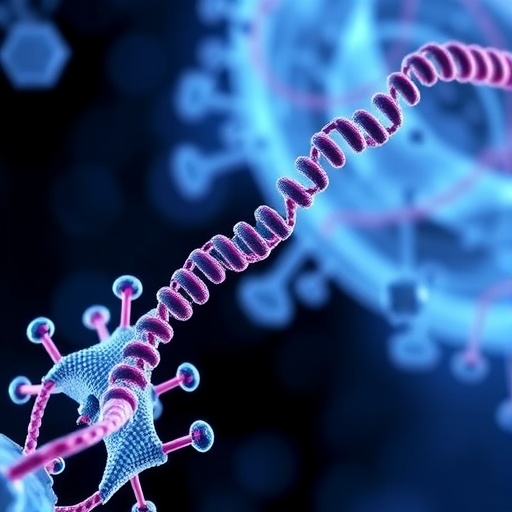In a groundbreaking development for gene therapy, researchers have unveiled a novel point-of-care (POC) test designed specifically for the detection of adeno-associated virus type 8 (AAV8) binding antibodies in human plasma, serum, and whole blood. This innovative approach, utilizing Chembio’s Dual Path Platform (DPP) technology, promises to overcome significant obstacles posed by preexisting anti-AAV antibodies, which can severely impede the efficacy of AAV-mediated gene therapies. The significance of early detection of these antibodies cannot be overstated, as they can not only reduce therapeutic outcomes but also limit patient eligibility and lead to potentially serious health complications during treatment.
The AAV8 Total Antibody (TAb) assay, reported in a recent study, boasts a rapid turnaround time, providing results in just 20 minutes after the sample is introduced to the test system. This speed is particularly beneficial in a clinical setting, where timely decision-making is critical for patient outcomes. The assay exhibits a dynamic measurement range of 0 to 32 µg/ml when tested with purified human polyclonal antibodies that specifically target AAV8. Such a wide range facilitates accurate quantification of antibodies, thus enhancing the reliability of the test.
In terms of specificity and sensitivity, the DPP AAV8 TAb assay aligns closely with Chembio’s established AAV8 TAb ELISA, achieving a correlation coefficient (R²) of 0.90. This strong concordance underscores the test’s potential utility in routine clinical applications. Furthermore, the assay has also demonstrated robust correlations with neutralizing antibody (NAb) tests, displaying an impressive R² value of 0.97 when compared with Chembio’s AAV8 NAb ELISA and adapted cell-based NAb assays, specifically focusing on plasma samples.
A notable aspect of this research is its practical applicability for screening potential candidates for AAV8-mediated gene therapy. Pre-existing AAV8 binding antibodies can indeed present a formidable barrier to effective treatment, as they can neutralize the therapeutic effects of the administered viral vector, rendering gene therapy less effective or altogether ineffective. By enabling rapid testing at the point of care, this assay design presents an opportunity for healthcare providers to make more informed treatment decisions, tailoring gene therapies to those who are most likely to benefit.
The DPP technology employed in this test has been noted for its versatility and ease of use, allowing for deployment in various clinical environments, including outpatient clinics and doctors’ offices. This accessibility aligns with the ongoing push for decentralization of healthcare diagnostics, granting patients faster access to essential medical information without the need for extensive laboratory facilities or prolonged wait times.
In addition to improving patient outcomes, the rapid detection capabilities of the DPP AAV8 TAb assay can potentially streamline the clinical trial process for new gene therapies. Researchers can identify suitable trial candidates more efficiently and monitor immune responses to AAV vector administration more effectively. Such improvements could lead to faster timelines for therapeutic development and enhanced safety profiles for innovative gene therapies.
The implications of this assay extend beyond screening for therapeutic suitability; it also paves the way for further research into the immune responses elicited by AAV vectors. Understanding the dynamics of antibody production following AAV exposure could inform strategies to mitigate immune-related complications during gene therapy. Additionally, the data gathered from widespread use of this test could significantly enhance knowledge regarding the prevalence and impact of pre-existing antibodies within diverse populations and clinical settings.
As the field of gene therapy progresses, the ability to detect and quantify antibodies quickly becomes increasingly critical. Studies have shown that a substantial proportion of patients have preexisting antibodies to AAV vectors, thus highlighting the urgency for reliable diagnostic tools. This new assay could very well serve as a standard initial evaluation for potential gene therapy recipients, ensuring that only suitable individuals proceed with treatment based on their immunological profile.
Moreover, addressing the challenge presented by preexisting antibodies also opens doors for the future development of engineered AAV variants designed to evade the immune response. By identifying patient-specific responses, researchers could tailor therapies that might avoid neutralization, thus enhancing the effectiveness of AAV-mediated gene therapies.
Importantly, the ongoing collaboration between researchers and clinical institutions underscores a broader goal of translating scientific advancements into practical, real-world solutions for patients. The research team, comprised of notable figures such as Kozikowski, Wang, and Yang, among others, showcases a commitment not only to scientific excellence but also to improving patient care through innovative technologies.
In conclusion, the development of the DPP AAV8 Total Antibody assay represents a significant advancement in the landscape of gene therapy. By addressing the critical challenge posed by preexisting antibodies, this rapid, quantitative test embodies a pivotal step toward enhancing the effectiveness of AAV-mediated therapies. As the field evolves, the integration of such diagnostic tools will be essential in paving the way for successful gene therapy outcomes, ultimately changing the lives of patients worldwide.
Subject of Research: Detection of AAV8 binding antibodies in gene therapy candidates
Article Title: Rapid detection of AAV8 binding antibodies in gene therapy candidates: development of a point-of-care approach.
Article References:
Kozikowski, A., Wang, Q., Yang, C. et al. Rapid detection of AAV8 binding antibodies in gene therapy candidates: development of a point-of-care approach.
Gene Ther (2025). https://doi.org/10.1038/s41434-025-00559-0
Image Credits: AI Generated
DOI: 10.1038/s41434-025-00559-0
Keywords: AAV8, gene therapy, antibodies, point-of-care testing, immunology, diagnostics, viral vectors, therapeutic efficacy, patient screening, clinical application.




